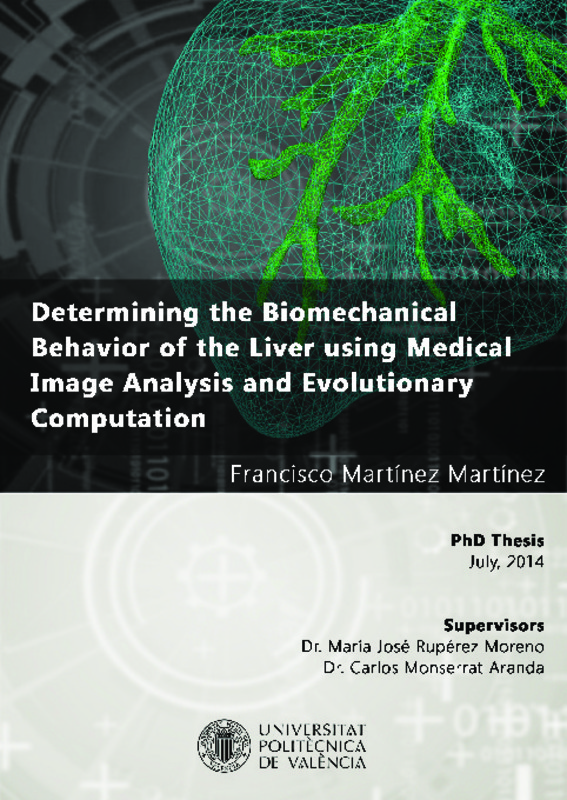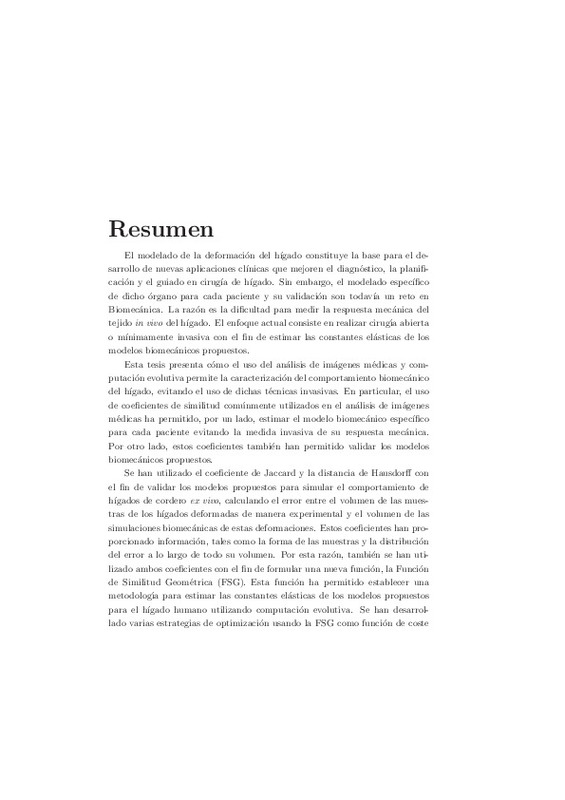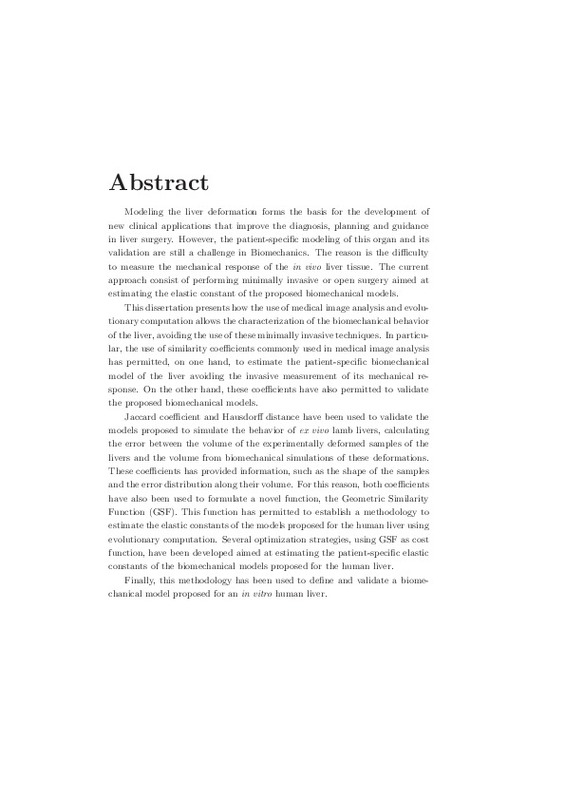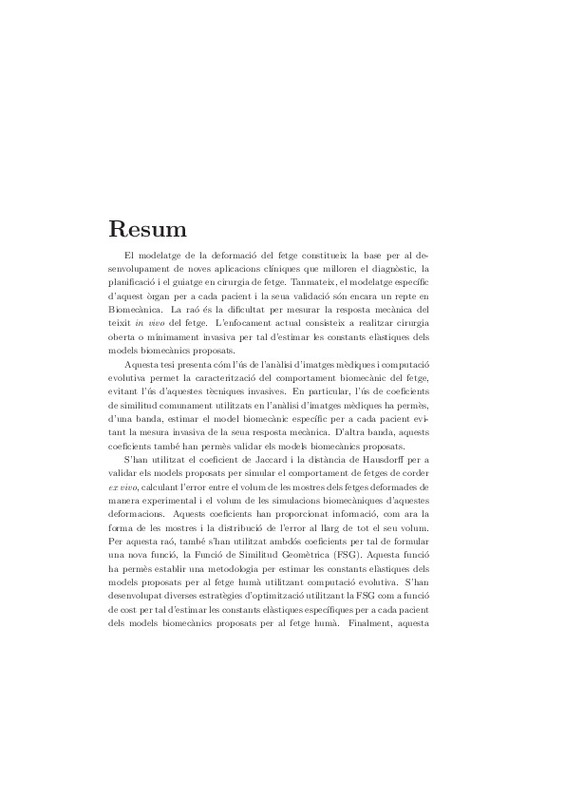- RiuNet repositorio UPV
- :
- Investigación
- :
- Tesis doctorales
- :
- Ver ítem
JavaScript is disabled for your browser. Some features of this site may not work without it.
Buscar en RiuNet
Listar
Mi cuenta
Estadísticas
Ayuda RiuNet
Admin. UPV
Determining the Biomechanical Behavior of the Liver Using Medical Image Analysis and Evolutionary Computation
Mostrar el registro sencillo del ítem
Ficheros en el ítem
| dc.contributor.advisor | Monserrat Aranda, Carlos
|
es_ES |
| dc.contributor.advisor | Rupérez Moreno, María José
|
es_ES |
| dc.contributor.author | Martínez Martínez, Francisco
|
es_ES |
| dc.date.accessioned | 2014-09-03T06:58:13Z | |
| dc.date.available | 2014-09-03T06:58:13Z | |
| dc.date.created | 2014-07-16T09:30:16Z | es_ES |
| dc.date.issued | 2014-09-03T06:58:08Z | es_ES |
| dc.identifier.uri | http://hdl.handle.net/10251/39337 | |
| dc.description.abstract | Modeling the liver deformation forms the basis for the development of new clinical applications that improve the diagnosis, planning and guidance in liver surgery. However, the patient-specific modeling of this organ and its validation are still a challenge in Biomechanics. The reason is the difficulty to measure the mechanical response of the in vivo liver tissue. The current approach consist of performing minimally invasive or open surgery aimed at estimating the elastic constant of the proposed biomechanical models. This dissertation presents how the use of medical image analysis and evolutionary computation allows the characterization of the biomechanical behavior of the liver, avoiding the use of these minimally invasive techniques. In particular, the use of similarity coefficients commonly used in medical image analysis has permitted, on one hand, to estimate the patient-specific biomechanical model of the liver avoiding the invasive measurement of its mechanical response. On the other hand, these coefficients have also permitted to validate the proposed biomechanical models. Jaccard coefficient and Hausdorff distance have been used to validate the models proposed to simulate the behavior of ex vivo lamb livers, calculating the error between the volume of the experimentally deformed samples of the livers and the volume from biomechanical simulations of these deformations. These coefficients has provided information, such as the shape of the samples and the error distribution along their volume. For this reason, both coefficients have also been used to formulate a novel function, the Geometric Similarity Function (GSF). This function has permitted to establish a methodology to estimate the elastic constants of the models proposed for the human liver using evolutionary computation. Several optimization strategies, using GSF as cost function, have been developed aimed at estimating the patient-specific elastic constants of the biomechanical models proposed for the human liver. Finally, this methodology has been used to define and validate a biomechanical model proposed for an in vitro human liver. | en_EN |
| dc.language | Inglés | es_ES |
| dc.publisher | Universitat Politècnica de València | es_ES |
| dc.rights | Reserva de todos los derechos | es_ES |
| dc.source | Riunet | es_ES |
| dc.subject | Biomechanical modeling | es_ES |
| dc.subject | Liver | es_ES |
| dc.subject | Jaccard | es_ES |
| dc.subject | Hausdorff | es_ES |
| dc.subject | Scatter Search | es_ES |
| dc.subject | Genetic Algorithms | es_ES |
| dc.subject.classification | LENGUAJES Y SISTEMAS INFORMATICOS | es_ES |
| dc.title | Determining the Biomechanical Behavior of the Liver Using Medical Image Analysis and Evolutionary Computation | |
| dc.type | Tesis doctoral | es_ES |
| dc.identifier.doi | 10.4995/Thesis/10251/39337 | es_ES |
| dc.rights.accessRights | Abierto | es_ES |
| dc.contributor.affiliation | Universitat Politècnica de València. Departamento de Ingeniería Electrónica - Departament d'Enginyeria Electrònica | es_ES |
| dc.description.bibliographicCitation | Martínez Martínez, F. (2014). Determining the Biomechanical Behavior of the Liver Using Medical Image Analysis and Evolutionary Computation [Tesis doctoral]. Universitat Politècnica de València. https://doi.org/10.4995/Thesis/10251/39337 | es_ES |
| dc.description.accrualMethod | TESIS | es_ES |
| dc.type.version | info:eu-repo/semantics/acceptedVersion | es_ES |
| dc.relation.tesis | 7305 | es_ES |
Este ítem aparece en la(s) siguiente(s) colección(ones)
-
Tesis doctorales [5389]












